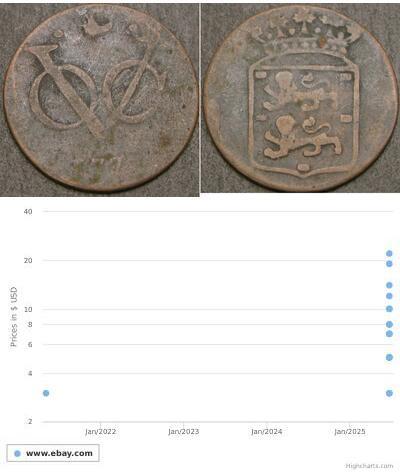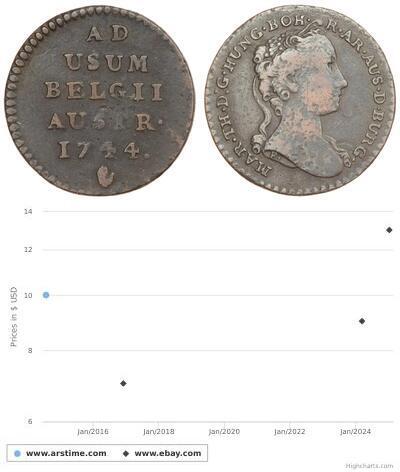1/24 Daler (sold for $111.0)
1672, Pomerania (Swedish Occupation), Charles XI. Silver 1/24 Daler Coin. VF+
Mint Year: 1672 Reference: KM-252. Denomination: 1/24 Daler (1/24 Thaler) Condition: Dark oxidation deposits, otherwise VF+ Diameter: 22mm Weight: 1.66gm Material: Silver
Obverse: Crowned griffin with sword in right claw left. Legend around. Legend: CAROLUS D G REX SUECIAE D S P ... Reverse: Fractional value numeral (24) abeove denomination (EINEN REICHS DALER). Legend: IN IEHOVA SORS MEA 1762 * D S
Swedish Pomerania (Swedish: Svenska Pommern; German: Schwedisch-Pommern) was a Dominion under the Swedish Crown from 1630 to 1815, situated on what is now the Baltic coast of Germany and Poland. Following the Polish War and the Thirty Years' War, Sweden held extensive control over the lands on the southern Baltic coast, including Pomerania and parts of Livonia and Prussia (dominium maris baltici).
Sweden, present in Pomerania with a garrison at Stralsund since 1628, had gained effective control of the Duchy of Pomerania with the Treaty of Stettin in 1630. At the Peace of Westphalia in 1648 and the Treaty of Stettin in 1653, Sweden received Western Pomerania (German Vorpommern), with the islands of Rügen, Usedom, and Wolin, and a strip of Farther Pomerania (Hinterpommern). The peace treaties were negotiated while the Swedish queen Christina was a minor, and the Swedish Empire was governed by members of the high aristocracy. As a consequence, Pomerania was not annexed to Sweden like the French war gains, which would have meant abolition of serfdom, since the Pomeranian peasant laws of 1616 was practised there in its most severe form. Instead, it remained part of the Holy Roman Empire, making the Swedish rulers Reichsfürsten (imperial princes) and leaving the nobility in full charge of the rural areas and its inhabitants. While the Swedish Pomeranian nobles were subjected to reduction when the late 17th century kings regained political power, the provisions of the peace of Westphalia continued to prevent the pursuit of the uniformity policy in Pomerania until the Holy Roman empire was dissolved in 1806.
In 1679, Sweden lost most of her Pomeranian possessions east of the Oder river in the Treaty of Saint-Germain-en-Laye, and in 1720, Sweden lost her possessions south of the Peene and east of the Peenestrom rivers in the Treaty of Stockholm. These areas were ceded to Brandenburg-Prussia and were integrated into Brandenburgian Pomerania. Also in 1720, Sweden regained the remainder of her dominion in the Treaty of Frederiksborg, which had been lost to Denmark in 1715. In 1814, as a result of the Napoleonic Wars, Swedish Pomerania was ceded to Denmark in exchange for Norway in the Treaty of Kiel, and in 1815, as a result of the Congress of Vienna, transferred to Prussia.
Charles XI or Carl (Swedish: Karl XI; 4 December [O.S. 24 November] 1655 – 15 April [O.S. 5 April] 1697)[2] was King of Sweden from 1660 until his death, in a period of Swedish history known as the Swedish Empire (1611–1721).
He was the only son of King Charles X Gustav of Sweden and Hedwig Eleonora of Holstein-Gottorp. His father died when he was four years old, so Charles was educated by his governors until his coronation at the age of seventeen. Soon afterward, he was forced out on military expeditions to secure the recently acquired dominions from Danish troops in the Scanian War. Having successfully fought off the Danes, he returned to Stockholm and engaged in correcting the country's neglected political, financial, and economic situation. He managed to sustain peace during the remaining 20 years of his reign. Changes in finance, commerce, national maritime and land armaments, judicial procedure, church government, and education emerged during this period. Charles XI was succeeded by his only son Charles XII, who made use of the well-trained army in battles throughout Europe.
The fact that Charles was crowned as Charles XI does not mean that he was the 11th king of Sweden who had the name Charles. His father's name (as the 10th) was due to his great-grandfather, King Charles IX of Sweden (1604–1611), having adopted his own numeral by using a mythological History of Sweden. That ancestor was actually the third King Charles. The numbering tradition thus begun still continues, with the present king of Sweden being Carl XVI Gustaf. He has also once been called Charles IV.

|
Posted by:
anonymous 2021-11-21 |
|
||
|
||
|
||
|
||
 English
English

















